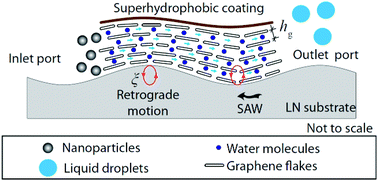Acoustially-mediated microfluidic nanofiltration through graphene films
Abstract
We exploit the possibility of enhancing the molecular transport of liquids through graphene films using amplitude modulated surface acoustic waves (SAWs) to demonstrate effective and efficient nanoparticle filtration. The use of the SAW, which is an extremely efficient means for driving microfluidic transport, overcomes the need for the large mechanical pumps required to circumvent the large pressure drops encountered in conventional membranes for nanoparticle filtration. 100% filtration efficiency was obtained for micron-dimension particulates, decreasing to only 95% for the filtration of particles of tens of nanometers in dimension, which is comparable to that achieved with other methods. To circumvent clogging of the film, which is typical with all membrane filters, a backwash operation to flush the nanoparticles is incorporated simply by reversing the SAW-induced flow such that 98% recovery of the initial filtration rate is recovered. Given these efficiencies, together with the low cost and compact size of the chipscale SAW devices, we envisage the possibility of scaling out the process by operating a large number of devices in parallel to achieve typical industrial-scale throughputs with potential benefits in terms of substantially lower capital, operating and maintenance costs.



 Please wait while we load your content...
Please wait while we load your content...